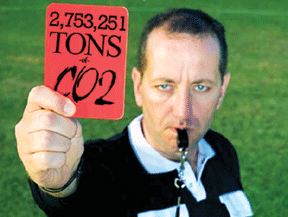the carbon footprint of the 2010 world cup
If you thought that those pesky vuvuzela were the worst thing about the 2010 World Cup, wait until you hear about the carbon emissions estimated to be released during the planet’s biggest sporting event. According to a study conducted by the Norwegian Embassy and South African government on the eve of the games, this year’s World Cup will emit 2,753,251 tons of CO2 into the atmosphere, which is roughly equivalent to the amount released by one million cars over the course of a year – and six times worse than those emitted during the last World Cup.
Several factors surrounding the 2010 World Cup in South Africa have led to a higher carbon footprint than in years past. For one, far more people arrived to the games on international flights as opposed to by rail or car, which was the case for the 2006 World Cup in Berlin. The Norwegian report estimates that the total emissions from transportation will reach 1,856,589 tons.
According to the study, another 15,390 tons of CO2 went into building infrastructure to support the games. A shortage of soccer stadiums in South Africa meant that new ones needed to be built, meaning cement needed to be produced, and at a high cost to the environment. In manufacturing one ton of cement, a ton of CO2 is emitted, reports Super Mundo. South Africa’s reliance on “coal burning plants for power means the energy usage of the influx of tourists will result in the release of 340,128 tons of carbon dioxide.
To better paint a picture of just how much CO2 will be released during this World Cup, The Guardian makes some eye-opening comparisons. Apparently, the games will emit as much CO2 as 6,000 space shuttle fights or a whopping one billion cheeseburgers.
That is not to say, however, that South Africa didn’t take measures to reduce the carbon footprint of the World Cup. A rail network was built to more efficiently move visitors to and from the games,
easing the emissions from traffic. The government also plans to offset at least a portion of the emitted carbon by planting hundreds of thousands of trees in urban areas throughout the country.
Shared with tbl by treehugger






